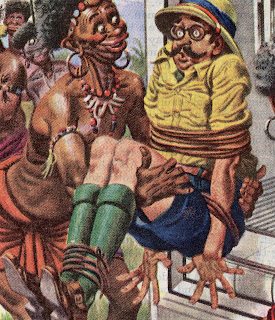"The shudder of awe," wrote Goethe, "is humanity's highest faculty." This helps explain why some people are attracted to the arts. But other people who aren't comfortable shuddering have found more orderly ways to approach art.
For example, art historians try to understand art by researching the lives of artists. (The
new biography of Saul Steinberg, a splendid piece of scholarship, devotes 732 pages to how Steinberg's childhood, his sex life, and his paternal grandfather shaped the pictures we think we enjoy today.)
Chemists analyze the composition of pigments for whatever insights chemistry can contribute. Radiologists x-ray paintings, searching for earlier, discarded drafts. Psychologists rummage through an artist's underwear drawer for psychological explanations for creative decisions.
But that's not the worst of it. Prominent economist David Galenson explains that with the benefit of new "quantitative methods," we can now conclusively list the top 25 "most important works of art of the 20th century." (Number one is Picasso's Demoiselles D'Avignon, in case you wanted to know.)Physicist Charles Falco, an expert in molecular beam epitaxy, won headlines with his "scientific proofs" and "mathematical calculations" explaining how great artists painted pictures. Statisticians have even resolved the long debate over the merits of drawing vs. painting. According to the experts at Artprice.com: Drawing is no longer and will never more be considered a poor relation to painting.... [O]ver the last ten years (January 2002 – January 2012) the price index for drawings has progressed more than 197% versus 161% for that of painting.
Don't think for one minute that Artprice.com's researchers shy away from the big issues. Here they address "the entire anguish of humanity":Edvard Munch’s The Scream, which condenses in a single image of just 79 x 59 cm the entire anguish of humanity, can be considered the “Mona Lisa of Expressionism.” In just one adjudication, the Norwegian artist has completely outperformed his 2011 revenue total ($7,645,527 from 82 lots ) and has gained the potential to climb to a substantially higher level in the global ranking of artists by annual auction revenue (219th in 2011).
Ambitious academics, authors and social scientists are emboldened by the triumph of information technology, clambering over the arts like over-ardent monkeys. They mistake information for ideas, and rarely come into contact with that "shudder of awe" stuff that Goethe wrote about.
A survey of 230 art critics by Columbia University found that passing judgment on art was at the bottom of their list of priorities, while "providing an accurate descriptive account" was at the top. Such descriptions provide information, but there is a big difference between information and wisdom. James Elkins, chair of art history at the Art Institute of Chicago, concluded that "contemporary art criticism is entranced by the possibility of avoiding judgment."
If your prejudices are anything like mine, right about now you should be objecting: "How can more information ever be a bad thing? Are we supposed to avert our eyes from scientific data? Is art just some magic trick we shouldn't spoil by thinking too much about how it is done?"
I am a big fan of scientific research, but science and art seem to work by different rules. In science, each new fact brings us closer to truth but in art, more facts can take us farther from-- not closer to-- the highest aesthetic experience. Facts can dilute the most meaningful aspects of art. They can distract and deceive the viewer. Art can wilt under the weight of too much empirical data.
Michelangelo destroyed his preliminary drafts because he wanted the final work stand alone; forensic investigations would only siphon off attention from the important parts. For the same reason, Matisse claimed that "all artists should have their tongues cut out." While we should not necessarily limit ourselves to Michelangelo's or Matisse's notions of the best way to experience their art, we should at least think twice before adopting the alternative approach offered by some ambitious economist.
Furthermore, my disagreement with scholarly research should not be viewed as anti-science. To the contrary, science itself offers us a more suitable model for connecting with art:
Chemistry tells us that the strongest bond between two substances is formed when their molecular structures are not too complete, and thus they are receptive to sharing pairs of electrons between them. A substance with gaps in its electrons can fill those gaps with the electrons of another substance. In this way, two molecules can unite into one bigger molecule-- a connection called a covalent bond, heavily crosslinked and powerful in a way no mere glue can match. (This is why
epoxy, which combines the electrons of two ingredients, is so much stronger than regular glue applied unilaterally to a surface.)
No matter how much scientific data we compile to understand and capture an art object, we will never bond with it the way we might if we kept our outer electron ring open and receptive. If we come to art fortified with too much information, we have fewer free electrons available for the new combinations that make so much of art worthwhile.
Ambiguity is the enemy of science, but ambiguity in art is a precious thing; it provides the space essential for personalizing our reactions. A covalent bond with art enables us to find greater inspiration than the art might supply if we simply followed a script produced through factual research.
There's no doubt that research provides genuine benefits to art dealers, historians, grad students, voyeurs and economists. At the same time, it can hinder a more meaningful relationship with art. Anyone who still yearns for Goethe's shudder of awe may find scholarship a poor substitute.




























































